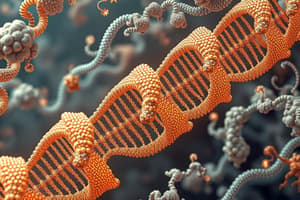Podcast
Questions and Answers
What is the fate of proteins synthesized by free polyribosomes?
What is the fate of proteins synthesized by free polyribosomes?
- They are secreted from the cell
- They are targeted for degradation by proteasomes
- They are incorporated into the ER membrane
- They are destined for the cytosol, nucleus, mitochondria, and peroxisomes (correct)
Which of the following is NOT a function of the cytoskeleton?
Which of the following is NOT a function of the cytoskeleton?
- Intracellular trafficking
- DNA replication (correct)
- Determination of cell shape
- Positioning of organelles
What is the primary role of the 'signal hypothesis' in protein synthesis?
What is the primary role of the 'signal hypothesis' in protein synthesis?
- Directing proteins to their correct destination in the cell (correct)
- Identifying the location where proteins are synthesized
- Explaining the mechanism of protein folding
- Regulating the rate of protein synthesis
What happens to misfolded proteins that are synthesized by both free and ER-bound polyribosomes?
What happens to misfolded proteins that are synthesized by both free and ER-bound polyribosomes?
Which type of cytoskeletal element is known for its dynamic instability and treadmilling?
Which type of cytoskeletal element is known for its dynamic instability and treadmilling?
Which of the following is NOT a factor that determines the fate of newly synthesized proteins?
Which of the following is NOT a factor that determines the fate of newly synthesized proteins?
What is the primary function of the unfolded protein response (UPR)?
What is the primary function of the unfolded protein response (UPR)?
Which cellular component is responsible for the degradation of proteins via the ubiquitin-proteasome pathway?
Which cellular component is responsible for the degradation of proteins via the ubiquitin-proteasome pathway?
Which of the following statements accurately describes the relationship between ribosomes, polyribosomes, and the ER?
Which of the following statements accurately describes the relationship between ribosomes, polyribosomes, and the ER?
What is the difference in function between lysosomes and proteasomes in protein degradation?
What is the difference in function between lysosomes and proteasomes in protein degradation?
Flashcards
Protein Synthesis
Protein Synthesis
The process of creating proteins from genetic information.
Protein Folding
Protein Folding
The process of a protein being folded into its correct three-dimensional shape.
Rough Endoplasmic Reticulum (rER)
Rough Endoplasmic Reticulum (rER)
Location in the cell where proteins are synthesized by ribosomes.
Proteins synthesized by free ribosomes
Proteins synthesized by free ribosomes
Signup and view all the flashcards
Proteins synthesized by ribosomes attached to the ER
Proteins synthesized by ribosomes attached to the ER
Signup and view all the flashcards
Signal Peptide
Signal Peptide
Signup and view all the flashcards
Protein Refolding
Protein Refolding
Signup and view all the flashcards
Unfolded Protein Response (UPR)
Unfolded Protein Response (UPR)
Signup and view all the flashcards
Proteasome
Proteasome
Signup and view all the flashcards
Lysosome
Lysosome
Signup and view all the flashcards
Study Notes
Cell Biophysiology - Learning Objectives
- Describe protein synthesis.
- State the fate of proteins synthesized in the rough endoplasmic reticulum (rER) and those synthesized by free ribosomes.
- Explain the signal hypothesis in protein synthesis.
- List the factors that determine the fate of newly synthesized proteins.
- Explain the function of the unfolded protein response and its value to the cell.
- Compare the mechanisms by which proteins are targeted for degradation by proteasomes or lysosomes.
Cytoskeleton
- Explain the role of the cytoskeleton in determining cell shape, positioning of organelles, intracellular trafficking, and cell movement.
- Compare the characteristics and functions of microfilaments, microtubules, and intermediate filaments.
- Explain treadmilling of actin filaments and dynamic instability of microtubules.
- Explain how cytoskeletal dynamics control cellular movement.
Chromatin and Nucleolus
- Chromatin is DNA bound to histones and other proteins.
- Chromatin exists in two forms:
- Heterochromatin: Condensed chromatin, transcriptionally inactive (intensely stained).
- Euchromatin: Dispersed, unpacked chromatin, often actively transcribed (lightly stained).
- Nucleolus is the site of ribosomal RNA transcription and ribosome production (intensely stained).
Constitutive and Facultative Heterochromatin
- Constitutive heterochromatin: Repetitive, highly condensed throughout the cell cycle.
- Facultative heterochromatin: Not repetitive, may lose condensed state and become transcriptionally active.
Centrosome and Centriole
- Centrosome: The main microtubule organizing center (MOTC) of animal cells.
- Consists of a pair of orthogonal centrioles surrounded by pericentriolar material (PCM).
- PCM is responsible for microtubule anchoring.
- Centriole: A cylindrical structure (~200 nm in diameter) composed of a ring of nine triplets of microtubules.
Polyribosomes (Polysomes)
- Polyribosomes (polysomes): Multiple ribosomes bound to a single mRNA molecule.
- Simultaneously translate mRNA into many copies of a protein.
- Free polyribosomes synthesize cytosolic and cytoskeletal proteins.
- Polyribosomes attached to ER membranes synthesize proteins for incorporation into membranes, storage in lysosomes, or secretion from the cell.
Protein Synthesis - Signal Hypothesis
- mRNAs for proteins destined for the ER have an N-terminal signal sequence (signal peptide).
- Signal recognition particle (SRP) binds to the signal peptide.
- SRP binds to the SRP receptor and protein translocator complex in the ER membrane.
- Ribosome-SRP-nascent polypeptide complex attaches to the ER membrane.
- Signal peptidase removes the signal peptide in the lumen of the ER.
- Nascent polypeptide is translocated into the ER lumen. or becomes embedded in the ER membrane through the translocation complex.
- Other proteins (chaperones) "pull" the polypeptide through the translocator complex.
- The polypeptide folds properly in the ER cisterna.
ERAD (ER-Associated Degradation)
- New proteins that cannot be folded properly are targeted for degradation.
- Conjugated to ubiquitin.
- Degraded by proteasomes.
- This process is called the unfolded protein response (UPR).
UPR (Unfolded Protein Response)
- Helps maintain the balance of protein folding in the ER.
- Activated when unfolded proteins accumulate in the ER.
- Works to lower the number of unfolded proteins.
- Multiple mechanisms to achieve this.
- Unsuccessful UPR can lead to cell death.
Ubiquitin-Proteasome Pathway
- Ubiquitin-protein ligation: Ubiquitin attaches to the protein.
- Recognition by the 26S proteasome.
- Degradation of the ubiquitin-conjugated protein by the 26S proteasome.
- Release and recycling of ubiquitin.
Studying That Suits You
Use AI to generate personalized quizzes and flashcards to suit your learning preferences.




